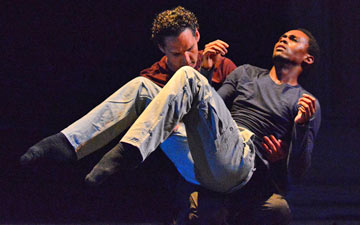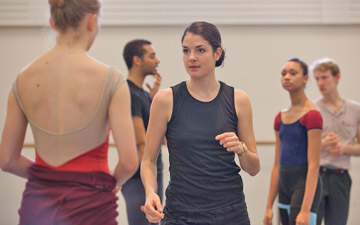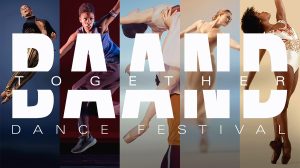
© Maria Baranova. (Click image for larger version)
Joyce Ballet Festival
Dancers from the Royal Ballet
Program A – An Evening of Solos and Duets: Asphodel Meadows pas de deux, Dance of the Blessed Spirits, Concerto pas de deux, Within the Golden Hour (Two Duets), Obsidian Tear, Qualia pas de deux, Jojo, Five Brahms Waltzes in the Manner of Isadora Duncan
★★★✰✰
New York, Joyce Theater
9 August 2019
joyce.org
www.roh.org.uk
Royal Visit
The Royal Ballet is an all-too-infrequent visitor to our city, so the two-week residency by a group of Royal Ballet dancers at the Joyce is particularly welcome. They come as part of the Joyce’s yearly Ballet Festival, which more typically showcases the repertories of smaller independent or regional American companies. Given the limitations of the venue (no orchestra pit, small stage), the Royal has been forced to shape its programs carefully, choosing small works and excerpts that involve a reduced number of dancers. Most of the music is recorded, though the elegant, sensitive playing of pianist Kate Shipway was one of the highlights of Program A, curated by the company’s director, Kevin O’Hare. Other programs have been put together by two company stars (Lauren Cuthbertson and Edward Watson) and a designer closely associated with the troupe, Jean-Marc Puissant.
Program A consisted of a string of solos and duets representing a slice of the company’s choreographic trajectory, from Frederick Ashton through Kenneth MacMillan to Liam Scarlett, Wayne McGregor, and Charlotte Edmonds. (Edmonds, in her early twenties, was the inaugural member of the Royal Ballet Young Choreographer Programme.) The almost gala-like format, it turns out, isn’t ideal, since a certain monotony sets in after the third or fourth pas de deux. The suite, performed roughly in chronological order, also had the perhaps unintended effect of underscoring the increasing tendency toward heavy-handed partnering and acrobatization of ballet technique, a trend that threatens to push the art of ballet into the realm of pure mannerism and decorativeness.

© Maria Baranova. (Click image for larger version)
One of the most striking works was the pas de deux from Kenneth MacMillan’s ballet Concerto, from 1966, set to Shostakovich’s Second Piano Concerto. It’s especially interesting for New York audiences, so accustomed to hearing this music in the context of Alexei Ratmansky’s Concerto DSCH, a local favorite. The pas de deux in these two ballets could not be more different. Ratmansky’s is a study of the vulnerability and intimacy of two people within the dynamics of a larger group. MacMillan’s, in contrast, is classical, transparent, almost impersonal. Where one choreographer hears vulnerability and anxiety, the other sees pure form. Lauren Cuthbertson, with her long, regal lines and luminous demeanor was absolutely stunning here. The pas de deux begins and ends with a series of slow cambrés, forward and back, with generous port de bras, executed while standing on pointe, almost as if the dancer were at her barre. Her partner, Nicol Edmonds, serves as a quiet, almost invisible support. Everything is repeated several times, in both directions. Symmetry, line, repetition – all produce a strong effect.
Two Ashton miniatures didn’t quite come off. The Dance of the Blessed Spirits, made for Anthony Dowell in 1978, and Five Brahms Waltzes, created for Lynn Seymour two years earlier, are dance portraits that live or die by the spirit and style with which they are performed. One is Apollonian, almost dream-like, and absolutely exposing; the other, ecstatic and over-the top. Joseph Sissens and Romany Pajdak are beautiful dancers, as they proved here and elsewhere, but there was an over-excited edge to their dancing here that made the choreography look fussy. Brahms Waltzes, in particular, verged into camp.
Then there were the pas de deux by Liam Scarlett (from Asphodel Meadows), Christopher Wheeldon (from Within the Golden Hour), and Wayne McGregor (from Obsidian Tear and Qualia). Each exhibited the qualities for which the choreographer is known: Scarlett’s moodiness, Wheeldon’s innovative and complex partnering, McGregor’s mannered agressiveness. The dancers look completely at home in these artists’ work. Their torsos bend and twist, each part of the body articulated to the utmost degree; no lift is too tricky, no position too uncomfortable. Sarah Lamb, in particular, is uncannily capable, her supreme serenity obscuring all hint of effort in Within the Golden Hour and Qualia.

© Maria Baranova. (Click image for larger version)
The latter, McGregor’s first piece for the Royal, is a portrait of sexual dynamics, performed to throbbing electronica by the multi-media musician Scanner, in what looks like underwear. Here, Lamb was partnered by the supple Edward Watson, exhibiting his usual rough-hewn charisma. Most of the partnering is executed from behind (a McGregor specialty), the better to see the manipulations of the woman’s body. Legs and feet are treated as erotic zones, handled roughly, pulled or pushed high into the air, or lowered ever-so-slowly to allow for extended admiration by the dancers onstage (and presumably the audience). Obsidian Tear, a fragment from a more recent McGregor work, for two men (Calvin Richardson and Joseph Sissens), is more exploratory, with hints of martial arts combat, same sex partnering, and undulations and twists for every part of the body. (It is set to a febrile violin solo by Esa-Pekka Salonen.) Sissens returned in the joyous bauble Jojo, by Charlotte Edmonds, a feel-good piece to playful Brazilian-infused pop.
Scarlett’s Asphodel Meadows and Wheeldon’s Within the Golden Hour show ballet in a more moody, romantic vein. Both are exceedingly pretty to look at; they satisfy the idea of ballet as a vehicle for gorgeousness, washed with an air of emotiveness. In Asphodel, the woman (Romany Pajdak) moves her arms first, almost like wings, setting in motion the Poulenc concerto in D Minor, beautifully-played by Kate Shipway. Soon Pajdak is echoed by her partner (Calvin Richardson). Fluid arms and backs play an important role in Scarlett’s style, as does elaborate, almost calligraphic partnering. At one point Richardson brings Pajdak to his shoulders, after which she lifts her leg high into the air; then he wraps her around his waist, and she maneuvers herself into a straddle. All this is done with extreme elegance and skill. Similarly, in Golden Hour, the bodies of the two dancers (Sarah Lamb and Marcelino Sambé) almost never separate, interlocking and scrolling in an endless phrase, fluid, supple, continuously evolving. “She looks like she doesn’t have bones!” someone near me exclaimed after it ended.
One can’t help but admire the dancers’ extraordinary skill and finesse. I find, though, that after a little while, the mind numbs to this uni-dimensional idea of ballet. Luckily there are three more programs in which to see other facets of the company and its repertory.

















You must be logged in to post a comment.